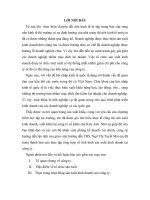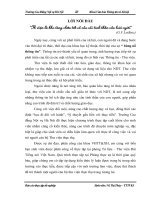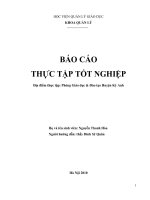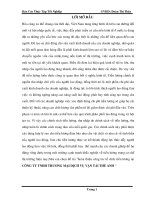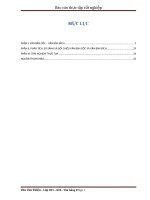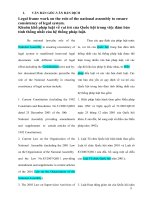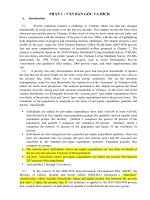Báo cáo thực tập tốt nghiệp tiếng anh (34)
Bạn đang xem bản rút gọn của tài liệu. Xem và tải ngay bản đầy đủ của tài liệu tại đây (184.59 KB, 49 trang )
PART I
INTRODUCTION
1. RATIONALE
We chose to write the graduation thesis about this topic
“An Investigation into Verb and Preposition Collocations” for
the following reasons.
Firstly, the problem for learners of English is that there
are no collocation rules that can be learned. Native English
speakers intuitively make the correct collocation, based on
a lifetime, experience of hearing and reading the words in
the set of combinations. Therefore, we want to concentrate
in this thesis on the problem which non-native speakers
may have with English vocabulary use in particular with the
appropriate combination of words.
Secondly, non-native speakers have limited experience
of hearing very often in a daily life like native English
speakers. Then, they may frequently collocate words in a
way that sounds odd to native English speakers. When
talking to foreigners, non-native speakers always use a
single verb to talk. Therefore, it is very hard for the hearer
to understand what he/she said and it sounds unnatural in
the conversation as well.
Lastly, this is an interesting topic. To communicate
effectively with foreigners, non-native speakers should use
the correct combination of words to be clearly understood
for each other. Therefore, Verb and Preposition Collocations
will make learners of English interested in studying and
using them perfectly in a conversation. We hope that we
can contribute the small paper to learners of English who
are interested in Verb and Preposition Collocations.
2. AIMS OF THE STUDY
1
The first aim of the study is to make English learner’s
language natural and more easily understand.
The second is to help the English learner have the
alternative and richer way of expression.
The third aim is to help the English learner’s brain easily
remember and use language in chunks and blocks rather
than as single words.
The last aim is to classify verbs and prepositions into the
appropriate groups for the English learner to use it as the
study document.
3. SCOPE OF THE STUDY
a. The Verbs followed by the Preposition “Of”
b. The Verbs followed by the Preposition “To”
c. The Verbs followed by the Preposition “For”
d. The Verbs followed by the Preposition “From”
e. The Verbs followed by the Preposition “With”
f. The Verbs followed by the Preposition “At”
g. The Verbs followed by the Preposition “In”
h. The Verbs followed by the Preposition “On”
i. The Verbs followed by the Preposition “About”
4. METHODS OF THE STUDY
The study uses several methods to collect, analyze, and
synthesize data, including statistic, analytic, qualitative,
and quantitative methods.
5. DESIGN OF THE STUDY
PART I
INTRODUCTION
1. Rationale
2. Aims of the study
3. Scope of the study
4. Methods of the study
2
5. Design of the study
PART
II
DEVELOPMENT
Chapter 1. Theoretical background
Chapter 2. The investigation into verb and preposition
collocations
Chapter 3. Some suggested activities for learning
verb and preposition collocations
PART III
CONCLUSION
REFERENCES
APPENDIX
PART
CHAPTER 1
II
DEVELOPMENT
THEORETICAL BACKGROUND
1.1 WHAT IS VERB?
1.1.1 THE DEFINATION OF VERB
(Strumpf and Auriel (1999) define verbs as words that
express action, existence, or condition. Verbs are the life of
language. Because of them, our words take action and we
are able to express who we are and how we feel. Without
verbs, speech and writing would be reduced to trivial
naming and static description.
Some verbs express action:
We danced until three in the morning.
The rock band appreciated its unshakable sense of
time.
Other verbs indicate a condition or a state.
Bobby is miserable after losing his dog.
This new car looks beautiful.
Still others speak of existence of some persons or things.
3
Some of the buried workers are still alive.
This old car is on its last legs.
Verbs are words that show action or being. Whatever you
are doing can be expressed by a verb. A sentence can have
one word as long as that word is a verb; play, stop, run…
etc.
The verb is the heart of the predicate and usually the
most important part of the sentence. A verb or compound
verb asserts something about the subject of the sentence
and expresses actions, events, or state of being. (GUCKER,
1966)
1.1.2 TYPES OF VERB
(Randolph
and Sidney, 1982) In any language, the
topic of verb is large, and rather complicated. This chapter
deals with two general types of English verbs and how to
classify them. There are various ways to classify verbs in
this chapter. We begin with a classification relating to the
function of items in the verb phrase. There are two classes
of verbs in English:
1. The auxiliary verbs: these verbs include to be, to
have, to do, can, could, may, might, must, ought, shall,
should, will, would, to need, to dare and used to.
In linguistics, an auxiliary (also called helping verb,
helper verb, auxiliary verb, or verbal auxiliary) is a verb
whose function is to give further semantic or syntactic
information about the main or full verb following it. In
English, the extra meaning an auxiliary verb imparts alters
the basic from of the main verb to have one or more of the
4
following function s: passive, progressive, perfect and
modal.
In English, every clause has a finite verb that consists
of a full verb (a non-auxiliary verb) and optionally one or
more auxiliary verbs, each of which is a separate word.
Examples of finite verbs include write (no auxiliary verb),
have written (one auxiliary verb), and have been
written (two auxiliary verbs). Many languages, including
English, feature of verbs that can act either as auxiliary or
as full verbs such as be (“I am writing a letter” vs “I am a
postman”) and have (“I have written a letter” vs “I have a
letter”). In the case of be, it is sometimes ambiguous
whether it is auxiliary or not. For example, “The ice cream
was melted” could mean either “something melted the ice
cream” (in which case melt would be the main verb) or “
the ice cream was mostly liquid” (in which case be would
be the main verb).
The primary auxiliary verbs in English are to be and to
have, other major ones include shall, will, may, can and so
on.
There are ten modal verbs: can, could, may, might,
ought, shall, should, will, would, and must. They differ from
the other auxiliaries, that is to say they are detective verbs
and they can never function as main verbs. In general,
modal verbs express an assessment of possibility or
responsibility.
Some
of
them
can
be
viewed
representation of a conditional tense form in English.
5
as
2. Ordinary verbs: A verb says what a person or thing does and can
describe. It can occur in different forms according to their tenses and the
number and person of the subject. Ordinary verbs can be divided into two
general groups:
2.1. The action verb: transitive and intransitive
2.1.1 Transitive verbs: A transitive verb expresses an
action and is followed by an object that receives the action
of the verb.
In the following example, transitive verbs are
shown in the bold front and direct object of the verb is
underlined.
I washed the car yesterday.
I took my sister to the movie.
John studies English.
2.1.2 Intransitive verbs: An intransitive verb expresses
an action but is not followed by an object.
Applying test to an intransitive verb shows immediately
that an object cannot follow.
Tom’s grades improved with the help of a
tutor.
The child cried loudly.
The mother sang to her children.
2.2 Linking verbs: linking verbs do not show action. A
linking
verb
[also
called
copulative
verb]
links
or
establishes a relationship between the subject and its
complement. It describes or renames the subject.
She is angry.
6
The word is [a form of the verb to be] links the subject
she to the subject complement angry.
2.2.1 Linking verb followed by predicate noun:
My friend is a teacher.
Mike became a president of the company.
2.2.2 Linking verb followed by predicate adjective:
I feel nervous.
That pie tastes delicious.
List of common linking verbs: appear, become, feel,
get, go, grow, look, prove, remain, seem, smell, sound,
taste, turn and any form of the verb to be. See the verb
“To Be” below
Only become and seem are always linking verbs. Other
verbs from the list above sometimes can function as action
verbs.
In the following example, verbs feel and taste are
functioning as action verbs.
I feel pain from the injury.
Taste the pie and tell me if you like it.
To determine whether a verb is a linking verb substituted
am, is or are for the verb. If it fits-the substitute verb is a
linking verb.
In the following examples, verb feel is substituted
with am.
I
feel
I am nervous.
* Makes sense so feel is linking verb.
I feel pain from the injury.
7
nervous.
I am pain from the injury.
* In this case, it does not make sense so feel is
action verb.
1.1.3 CHARACTERISTICS OF VERBS
Verbs are associated with five primary characteristics:
number, person, voice, mood, and tense. These determine
what form a verb takes and how it is use din the sentences
(Strumpf and Auriel, 1999).
Number
The number of the verb indicates how many people,
creatures, or things a verb refer to. Number comes in just
two flavors: singular and plural. A singular refers to only
one person or thing, while a plural verb may refer to many.
8
SINGULAR
PLURAL
He runs.
They run.
She is
They are swimming.
swimming.
We win.
I win.
Person
We use the category of person to describe the
perspective from which the speaker makes his or her
statements or observations. Is he or she the person or
speaking or spoken to, or he or she the person or object
speaking or spoken of? There are three different persons
or perspectives that the verb can take: first person,
second person, and third person.
* First person
In the first person, the speaker includes himself or
herself as one who takes the action or whose condition is
described. This person is appropriate to situations where
the speaker wants to describe what he or she is doing,
seeing, or feeling. The first person employs the pronouns I
and we, and the first person verbs take the forms
appropriate to these pronouns.
I laugh at danger.
We were not pleased.
* Second person
In the second person, the speaker addresses the
person or people around him or her. This category of
person employs the pronoun you, (you, the individual)
9
and the plural form (you, a group). Again, the second
person verbs must take forms appropriate to these
pronouns.
You are not going to be happy when your
father gets home.
All of you drove here from Phoenix in that tiny
car.
* Third person
To speaker in the third person is to speak or write about
those around you. The third person perspective might be
that of a normal human observing his or her environment.
The third person employs the pronoun he, she, it, and
they or any third person noun. The third person verbs
must take forms appropriate to these pronouns or nouns.
She thinks of him fondly.
They caught the last train to Clarksville.
My old car may be ugly, but it runs well.
Voice
The voice of a verb indicates the strength of the
subject in a sentence. It tells us whether that subject takes
action or receives action. There are two possible voices:
active and passive. In the active voice, the stronger form,
the subject of the sentence takes the action of the verb.
Our army won the battle.
The subject army is strong since it takes action. This
sentence uses the active voice. In the passive voice, the
weaker form, the subject is acted upon.
The battle was won by our army.
10
In this sentence, the subject battle is weak because
receives the action of the army. It takes no action of its
own-a battle cannot win itself-and so the sentence uses
the passive voice.
Mood
In grammar the mood of the verb does not describe its
emotional state-as if a verb, a word, could feel joy or rage.
Instead, mood is a form of the verb that indicates a
speaker’s attitude toward his or her verb use of that verb.
Like an emotion, a grammatical mood is a state of mind.
To be more precise, it is the speaker’s mental conception
of the verb he or she is using. And, as opposed to the
hundred of emotions we can feel, there are just three
grammatical
moods:
indicative,
imperative,
and
subjunctive.
* Indicate mood
To use the indicative mood is to make a statement or
ask a question. It is the most commonly used of three
moods.
The pavement shimmered in the hot afternoon
sun.
Did you see that light in the sky?
In the first example, the verb shimmered indicates
what the pavement did. Here, the speaker is stating the
fact that “the pavement shimmered.” The indicative mood
always involves statements, questions, or exclamatory
sentences.
11
In the second sentence, the verb phrase did see, broken
by the pronoun you since the sentence is in the question
form, indicates what was seen in the sky. This sentence
questions a fact.
* Imperative mood
Verb in the imperative mood give commands for make
requests. Any time someone is told or asked to do
something, the verb used is in the imperative mood.
Wipe that grin off your face!
Set the VCR to begin recording at 9:30.
Please fetch me my slippers.
The first two examples are commands. The final
example is a request. The verb wipe, set, and fetch are
all in the imperative mood.
Verbs in the imperative mood are, by necessity, in the
second person. A request or command is always spoken
directly to another person or other persons. The second
person pronoun you is often left out but can be put back if
the speaker so desires.
* Subjunctive mood
Subjunctive mood verbs express wishes or make a
statement contrary to fact. They express hypothetical or
imaginary situations.
I wish I were with you.
If I had been there, none of this would have
happened.
If we lived in San Francisco, we would be
much happier.
12
Unless we go now, we will be late.
The conjunction if is frequently used with the
subjunctive mood, but the conjunction though, lest,
unless, that, and till may be used as well.
If I were thinner, I would eat more chocolate.
The verb were is in the subjunctive mood. It expresses
a condition contrary to fact. Sadly, I am not as thin as I
would
like
to
be,
so
I
must
limit
my
chocolate
consumption.
These constructions normally come in two parts. One
starts with a conjunction, such as if: If I were thinner. This
part contains the subjunctive verb and is called a
subordinate clause. It has a subject and a predicate but
cannot stand alone and make sense. The other shows the
result
of
hypothetical
situation:
I
would
eat
more
chocolate. This part can stand alone.
The subjunctive mood is also used to make
commands.
It is necessary that he be told immediately.
The verb phrase be told is in the subjunctive mood.
It is part of a subordinate clause beginning with the
conjunction that.
Over verbs are put in the subjunctive mood to express
a parliamentary motion.
I move that Mr. Bugle be permitted to keep
chickens in his yard.
Be permitted is a subjunctive verb, part of a
subordinate clause beginning with the conjunction that.
13
Tense
Every verb has a place in time. The action or state of
being may be immediate, in the here and now, it may
have happened some time ago. Or it may not have
happened yet. We talk of the placement of a verb in time,
its tenses, as being in the past, present, or future.
* Present Tense
In the present, you are reading this very sentence. The
verb phrases are reading is in the present tense. The
present tense includes only those actions or state of being
that exist in the immediate moment. Perhaps you are also
considering a trip to the kitchen, thinking, “I am hungry.’
The verb am is in the present tense.
* Past Tense
In the not too distant past, you read a sentence that
starts several lines above this one. The verb read,
pronoun with the short e, is in the past tense. In the more
distant past, you wisely purchased this book from the
local bookstore. The verb purchased is also in the past
tense. The past tense includes any action or state of being
that we could find between the dawn of time and a split
second before the present.
* Future Tense
In the near future, you will finish this page. The verb
phrase will finish is in the future tense. In the more
distant future, you will
finish
this book and will
recommend it to all of your friends. The verb phrases will
finish and will recommend are also in the future tense. The
14
future tense encompasses all actions or state of being we
might encounter between the briefest of moments after
the present and the end of time.
A verb in the future tense is, by necessity, in the form
of verb phrase. Because there are no future tense forms
for single verb, grammar demands that we use one of the
auxiliaries shall or will with a principal or main verb in a
verb phrase to create the future tense.
Our armies will vanquish our enemies.
I shall return.
The verb phrases will vanquish and shall return are
both in the future tense.
1.1.4 SUBJECT-VERB AGREEMENT
Perhaps the most commonly made mistake in
constructing a sentence
or clause is the failure to create
agreement between subject and verb. The form of verb
must match the person and number of the subject noun
(s) or pronoun (s). (Gucker Philip1966). In other words, if I
have the third person plural subject, such as doctors, I
must use the third person form of an appropriate verb,
such as operate.
The doctors operate on their patient. (correct third
person plural verb)
NOT The doctors operates on their patient. (incorrect third
person singular verb)
A plural subject requires a plural verb. A singular
subject requires a singular verb. A subject in the first
person requires a verb in the first person. A subject in the
15
second person requires a verb in the second person. No
matter what forms they come in, subject and verb agree.
In this agreement, you will find the key to the harmonious
sentence.
I see the sign. (correct first person singular verb)
NOT I sees the sign. (incorrect third person singular verb)
You know better than that. (correct second person
singular or plural)
NOT You knows better than that. (incorrect third person
singular verb)
Compound subject are composed of several nouns or
pronouns connected by and, either-or, neither-nor. Subject
connected by and almost always form a plural subject and
demand a plural verb.
Dogs and cats love to have their ears scratched.
Cream cheese and tomato are delicious on a bagel.
There are two exceptions to this rule. The first occur
when a seemingly compound and plural subject comes to
be regarded as singular through popular usage.
Bacon and egg is my favorite breakfast.
Corned beef and cabbage is an Irish tradition.
Under other circumstances, these subjects would be
plural and take a plural verb. However, people have come
to look at each set as a unit. These subjects have become
singular and need singular verbs.
The creator and champion of the sport is injured.
The cause and solution to our problem is this.
16
In the first sentence, the words creator and champion
refer to a single person, so the verb is singular. In the
second sentence, the words cause and solution refer to a
single object or issue. The verb must also be singular.
When two singular subjects are connected by either-or
or neither-or, we regard the complete subject as singular.
It then takes a singular verb.
Either the penguin or the seal eats my tuna
sandwich.
Neither Adam nor Dan takes out the trash.
When a singular subject and a plural subjects are
connected by either-or, or neither-nor, the verb takes the
number of whichever subject is closer.
Neither the manager nor the workers were
responsible for the accident.
Either the dogs or the cat is next in line for
bathtub.
In the first example, the plural subject workers is
nearer to the verb, so the verb is plural. In the second
example, the singular subject cat is closer to the verb. The
verb then is singular.
1.2 WHAT IS PREPOSITION?
1.2.1 DEFINITION OF PREPOSITION
(Strumpf and Auriel 1999.) Prepositions are words
that show the relationships between two words or phrase
in a sentence. Prepositions are the relationship words.
They relate some word or phrase to another word or
phrase, most often in term of location, direction or time.
17
(Thomson and Martinet 1986.) Prepositions are words
normally placed before nouns and pronouns. Prepositions
can be followed by a verb but, except after but and
except, the verb must be in the gerund form:
He is talking of emigrating.
They succeeded in escaping.
Students have two main problems with prepositions.
They have to know whether in any constructions a
preposition is required or not, and which preposition to use
when one is required.
The first problem can be especially troublesome to a
European
student,
who
may
find
that
a
certain
construction in his own language requires a preposition,
whereas a similar one in English does not, and vice versa:
e.g. in most European languages purpose is expressed by
a preposition + infinitive; in English it is expressed by the
infinitive only:
I came here to study.
Students should note also that many words used
mainly as prepositions can also be used as conjunctions
and adverbs.
1.2.2 FUNCTIONS OF PREPOSITION
Prepositions perform six prototypical functions within
sentences in the English language. Therefore, both native
English speakers and non-native speakers must learn and
understand the six grammatical functions to properly and
fully use prepositions in both speaking and writing English.
18
(Heather
Marie
Kosur
2009).The
six
functions
of
preposition are:
1. Preposition as subjects (Heather Marie Kosur
2009)
The first grammatical function that the prepositions can
perform is the subject. Subjects are defined as words,
phrase, and clauses that perform the action of or act upon
the verb.
Under the bed is filthy.
In the bathroom requires extra attention from the
housekeeper.
Near the living room window is leaking.
2. Preposition as subject complements
The second grammatical function that prepositions can
perform is the subject complement. Subject complements
are defined as words, phrases, and clauses that follow a
copular verb and describe the subject.
My hiding place is under the bed.
The best time to call is between six and nine.
A good place to study is in the library.
3. Preposition as direct objects
The third grammatical function that the preposition can
perform is the direct object. Direct objects are defined as
words, phrases, and clauses that follow a transitive verb
and receive the action of verb.
I cleaned under the bed.
The decorator has painted along the trim.
Mom organized in the closet.
19
4. Preposition as object complements
The fourth grammatical function that preposition can
perform is the object complement. Object complements
are defined as words, phrases, and clauses that directly
follow and describe the direct object.
Children often consider the scariest time of day
during the night.
The toddler has declared his hiding place under
the bed.
The student newspaper named the best place to
study in the library.
5. Preposition as indirect objects
The fifth grammatical function that preposition can
perform is the indirect object. Indirect objects are defined
as words, phrases, and clauses that follow a intransitive
verb and answer “to or for whom or what” the action of
verb is performed
The maid gave inside the refrigerator a
thorough scrubbing.
Have you given under the bed a good cleaning?
The farmer will be giving beyond his fields some
consideration.
6. Preposition as prepositional complements
The six grammatical function that preposition can
perform is the prepositional complement. Prepositional
complements are defined as words, phrases that function
as the object of prepositions.
I though about under the bed.
20
The eavesdropper is listening to inside the
boardroom.
Your mother always noses around in your
bedroom.
1.2.3 OBJECTS OF PREPOSITIONS
The object of preposition is usually a noun or a
pronoun, always in the object case. Though case has no
significant implications for standard nouns, it is quite
important to pronouns. Pronouns that function as objects
of the prepositions must take their objective case forms.
We returned the faulty merchandise to them.
(correct)
She arrived before him. (correct)
I would like to go to the dance with her. (correct)
Each of these pronoun objects is in the objective case
form. It would never do to use them in their nominative
case form.
We returned the faulty merchandise to they.
( incorrect )
She arrived before he. (incorrect)
I would like to go to the dance with she. (incorrect)
Notice that the object is usually, not always, a noun or
a pronoun.
Object may be also words from other parts of speech
that function as nouns. These noun substitutes are called
nominal.
* Nominal Adjectives:
His mood changed from angry to morose.
21
This day is somewhere between the sublime and
ridiculous.
* Nominal Adverbs:
Light fell on us from above.
We will take care of problem at once, Sir!
* Gerunds:
The object could also be a gerund, a verbal or verb
form that takes the place of a noun. The gerund always
ends in-ing.
I have nothing against dancing.
Running is near swimming on the gamut of
exhausting sports.
Remember that another verbal, the infinitive, uses to
as infinitive marker: to smile, to fly. Infinitives, however,
are not prepositional phrases. Though to is a part of the
infinitive, it does not have the prepositional ability to
establish a relationship between words. The verb portions
of infinitives (i.e., smile or fly) are not objects.
1.2.4 PREPOSITION OR ADVERB?
You may notice the words that seem to be
prepositions working outside of prepositional phrases.
These are not prepositions. In the same place,
(Strumpf
and Auriel 1999) they function without objects and are
adverbs.
The astronomy instructor asked her students to
look up.
The rescue team was told to stand by.
22
The office turned down my request for a
vacation.
The highlighted word in each example is an adverb. In
the first example, the adverb up modifies the infinitive to
look. It tells where the students were asked to look. In the
second example, the adverb by modifies the infinitive to
stand. It tells us where the team was told to stand. In the
third example, the adverb down modifies the verb turned.
It indicates where the request was turned.
1.3 WHAT IS COLLOCATION?
1.3.1 DEFINITION OF COLLOCATION
Collocation, as Oxford Dictionary defines, is the
habitual occurrence of a word with another word or words
with a frequency greater than chance.
A collocation is two or more words that often go
together. These combinations just sound “right” to native
English speakers, who use them all the time. On the other
hand, other combinations may be unnatural and just
sound “wrong”.
For example:
Natural English
Unnatural
English
The fast train
The quick
train
Fast food
Quick food
A quick shower
A fast
shower
A quick meal
A fast meal
23
Beare (1997) states that a collocation is made up of
two or more words that are commonly used together in
English. There are different kinds of collocation in English.
Strong collocations are word pairing that expected to
come together.
1.3.2 TYPES OF COLLOCATION
There are several different types of collocation.
Collocations can be noun + noun, adjective + adverb, verb
+ noun and so on. Here are eight types of collocation in
sample sentences (“Sample Collocations”, 1997).
1. Adverb + Adjective: completely satisfied [NOT
downright satisfied]
We entered a richly decorated room.
Invading that country was an utterly stupid thing
to do.
Are you fully aware of the implications of your
action?
2. Adjective + Noun: excruciating pain [NOT
excruciating joy]
He was writing on the ground in excruciating
pain.
The Titanic sank on its maiden voyage.
The doctor ordered him to take regular exercise.
3. Verb + Noun: commit suicide [NOT undertake
suicide]
The prisoner was hanged for committing
murder.
24
I always try to do my homework in the morning,
after making the bed.
He has been asked to give a presentation about
his work.
4. Noun + Verb: lion roar [NOT lion shout]
The lion started to roar when it heard the dog
barking.
Snow was falling as our plane took of.
The bomb went of when he started the car
engine.
5. Noun + Noun: a surge of anger [NOT a rush of anger]
Would like to buy bars of soap, please?
Let’s give Mr. Jones a round of applause.
The ceasefire agreement came into effect at
11 am.
6. Verb + Adverb: wave frantically [NOT wave
feverishly]
She placed her key gently on the table and sat
down.
Mary whispered softly in John’s ear.
I vaguely remember that it was growing dark
when we left.
7. Verb + Preposition: depend on [NOT depend of]
We had to return home because we had run of
out money.
At first, her eyes filled with horror, and then
she burst into tears.
25

